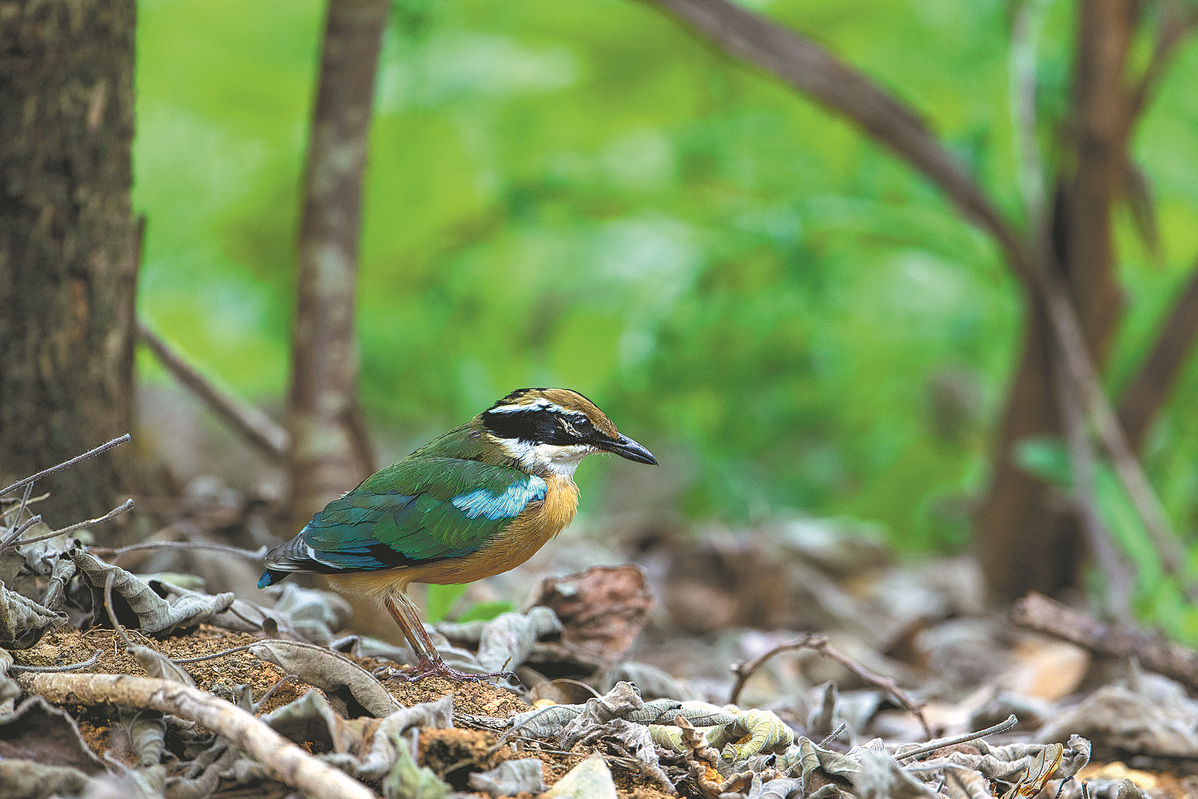India pitta bird accidentally found in China for first time
Source: China Daily | 2024-03-01 | Editor:Ines

A photo of a taxidermied India pitta made from a carcass found in Tianquan county, Sichuan province, last year stands in a forest. CHINA DAILY
In the depths of the tropical and subtropical forests in Asia, Australasia and Africa, there resides a unique group of birds.
Adorned with resplendent, colorful plumage, pittas are a highly secretive avian family of mostly nonmigratory species. They have been considered by many ornithologists and bird watchers as precious gems amidst the dim, dense woods, earning them the colloquial name "jewel-thrush".
Taxonomically, pittas belong to the Passeriformes order and the Pittidae family. Among the most beautiful birds in the world, most of the pitta species are shy by nature and elusive in their movements, and many species have narrow distributions and low populations, making them a sought-after target for numerous bird enthusiasts.
On the morning of June 15, an unexpected discovery was made when some residents stumbled upon the lifeless body of an unknown bird in the urban center of Tianquan county in Ya'an city, Sichuan province.
It was sent to the local forestry authorities, who then sought the expertise of Dr Que Pinjia, an ornithologist from the Chengdu Research Base of Giant Panda Breeding and the Sichuan Key Laboratory of Conservation Biology for Endangered Wildlife, to aid in identifying the deceased bird. Upon examining its morphological features, Que tentatively identified it as an Indian pitta (Pitta brachyura), a bird that had never been recorded in the country.
Further molecular biological analyses confirmed its taxonomic status. "It was truly a big surprise for us," Que said.
Since the bird's flight and tail feathers were intact, showing no obvious signs of artificial captivity, Que said the possibility of an escape was effectively ruled out. Consequently, the research team concluded that the appearance of the Indian pitta in Tianquan, Sichuan, marked the first recorded instance of this species within China, adding a "jewel" to the country's avian family.
He and five other researchers published the discovery in the January issue of Chinese Journal of Zoology, a science magazine of the Chinese Academy of Sciences, in an article titled "A New Bird Record in China: India Pitta".
Previous records in China documented sightings of eight pitta species, all of which have been put under State second-class protection due to their relatively scarce populations, said Que, who is the article's first author.
Aside from the fairy pitta, the other seven species have extremely narrow distributions within China, sporadically recorded in select locations near the southern border regions such as Hainan province, southern Yunnan province, and southern Guangxi Zhuang autonomous region, with very few records inland. "It further emphasizes the unexpected nature of the discovery," Que said.
According to the researcher, the Indian pitta is mainly distributed on the Indian subcontinent, ranging from Pakistan in the west to Bangladesh in the east. The distance between its nearest recorded location and Tianquan exceeds 1,000 kilometers, separated by grand mountain ranges from north to south.
"The origins of this bird have truly raised our curiosity," said professor Liu Yang from the School of Ecology at Sun Yat-sen University in Shenzhen, Guangdong province, a co-author of the study.
Liu said that similar instances include the records of bay-backed shrike (Lanius vittatus) and rusty-tailed flycatcher (Ficedula ruficauda) in Sichuan.
Both of these bird species are typically found in South Asia.
"Their appearance in Sichuan seems like an anomaly in the middle of nowhere," Liu said, adding that it seems like there's a "wormhole" between the bird's natural habitat and China.
While reasonable speculations can be made, Que said, a comprehensive understanding of the mechanisms behind these phenomena is dependent on the accumulation of more foundational information on bird distribution and migration, coupled with the application of various technological methods to conduct integrated research.
There are 44 species of pittas in the world. They are mostly found in forests, but some live in scrub and mangroves. They are highly terrestrial and mostly solitary, and usually forage on wet forest floors in areas with good ground cover.
You May Like
-
Forest guardians 'migrate' with the birds
Along with the birds flying over the Ailao Mountains in Yunnan province, a forest police team has likewise been "migrating" since September and will stay in the...
InKunming 2023-11-10 -
Paradise for birds
April 1 is International Bird Day. It has become an inescapable responsibility for human beings to protect birds and the biodiversity of the Earth.
InKunming 2023-04-03 -
Forest police protect migratory birds in Yunnan
Forest police from Hongtupo Township, southwest China's Yunnan Province recently finished their annual patrol of a famed stopover site and habitat for migratory...
InKunming 2023-02-20 -
Migratory birds discover paradise in Yunnan lake
Among the snow-capped peaks of Yulong Snow Mountain and the tranquil waters of Lashi Lake in Lijiang, Yunnan province, migratory birds flock to feed and play as...
InKunming 2022-11-09 -
Thousands of birds dance at a Honghe lotus pond
The lotus pond in Zhuyuan Township covers an area of over 13 thousand mu (866 hectares), with layers of green lotus leaves scattering above the water. After a b...
InKunming 2022-09-20 -
The number of bird species reaches 720 in Dehong
June 5 is World Environment Day. Also, on this very day, Liu Yang, a renowned ornithologist, and professor at the Ecology School of Sun Yat-sen University, iden...
InKunming 2022-06-09 -
More wild birds inhabit Kunming with a better environment
With the improved ecological environment in Kunming, there are an increasing number of wild birds coming to Kunming.
InKunming 2022-05-18 -
Rare bird photographed in Yunnan's nature reserve
An image of a rare bird was captured by a photographer recently in Napahai Lake Nature Reserve in Yunnan Province, southwest China.
InKunming 2022-04-24 -
How fancy birds can be? A fashion show in the bird's world
The male birds change their look with bright plumage and fancy haircuts to attract female birds, which make them quite fashionable.
InKunming 2022-04-22 -
A new member of Longling birds’ family
Recently, a new type of waterfowl was discovered in Longling County, Baoshan City, during a wildlife monitoring. This pretty waterfowl had been identified as th...
InKunming 2021-12-16







